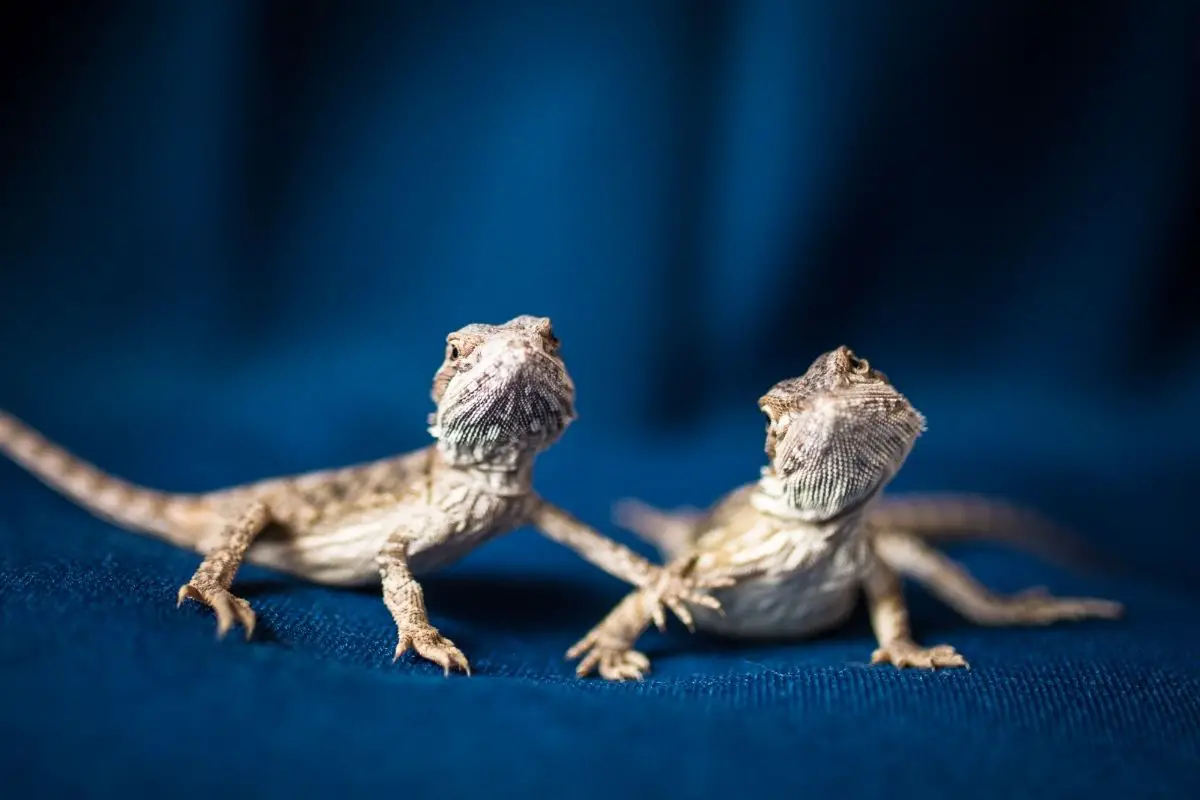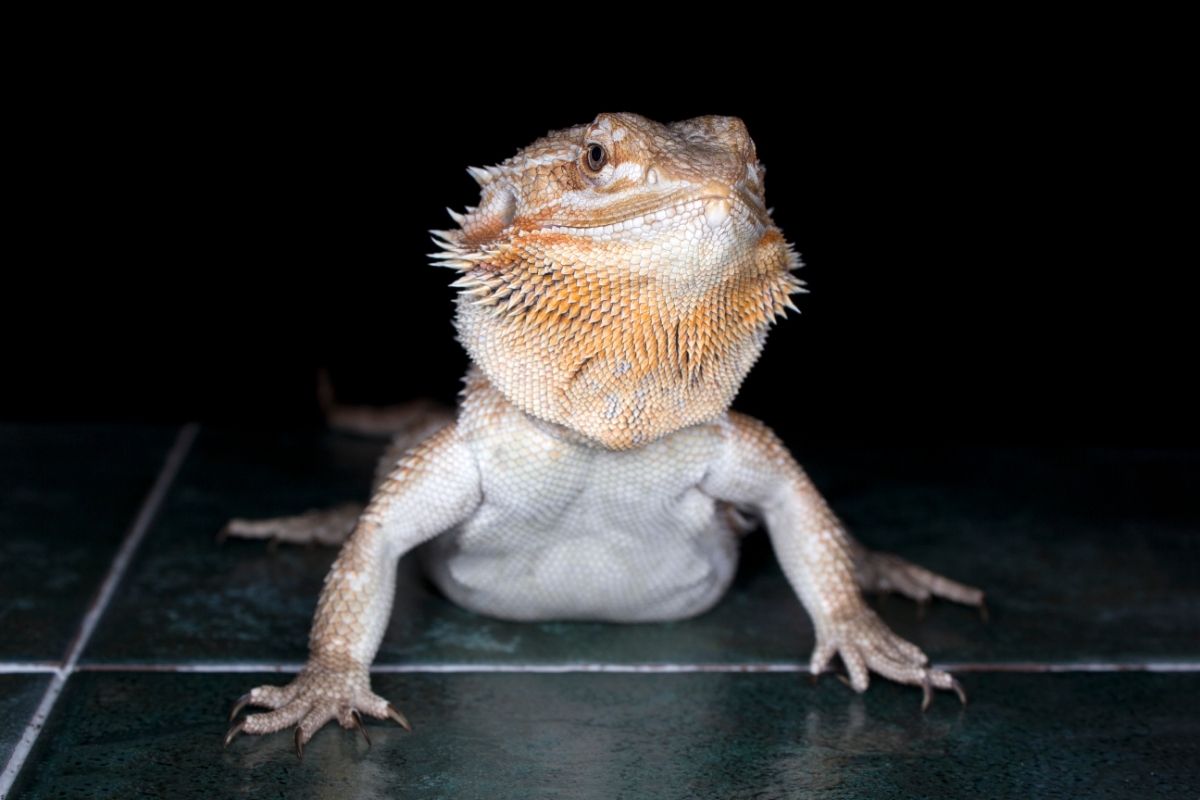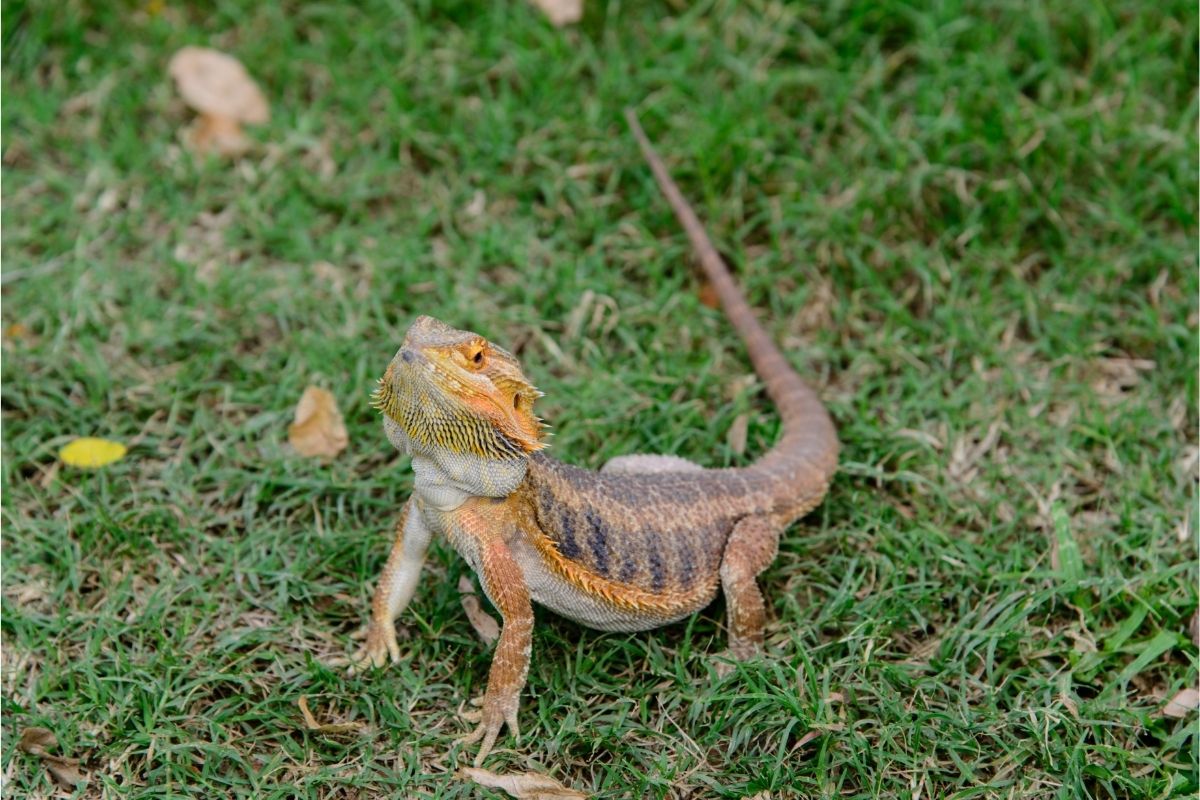When you think of a bearded dragon you probably think of a lizard walking on four legs.
But have you ever seen a bearded dragon run on two legs?
It is an unusual behavior that bearded dragons sometimes display.

But why do they do this?
If you want to learn more about bearded dragon behavior and what causes them to run on two legs, then keep reading.
We have done some research and put together this useful guide to help you understand more about bearded dragons.
Keep on reading to find out more!
What Is The Reason That Bearded Dragons Run On Two Legs?
Scientists used to believe that bearded dragons switched from running on four legs to running on two legs in order to increase their speed.
But if this was the case, you would expect the bearded dragons to begin running in an upright position in order to build up speed a lot faster.
You might be surprised to learn that it is actually physics that makes bearded dragons run on two legs.
Bearded dragons begin running on two legs.
As their speed increases, The effect of gravity causes their center of mass to change positions in their body.
This means that the bearded dragon is forced into an upright position, and they can support their weight using just their back legs.
As soon as their speed decreases, they will drop back to four legs.
Bearded dragons do not have the bodily structure to support their weight on two legs or to begin running from that position.
They can only switch from four legs to two legs once they have built up enough speed.
This is believed to be an evolutionary fault.
However, it actually serves a useful purpose, so it has remained.
When bearded dragons are running at a high enough speed to take on the upright position, they are actually much more efficient at changing direction than they are when using all four limbs.
This makes them more successful at catching prey and outrunning their predators, which is why the bearded dragons with this particular evolutionary fault survived and reproduced, passing on this trait to their offspring and the generations that followed.
If you want to find out more about how scientists learned about this behavior, then check out the studies performed by the University of Cambridge, where they observed the running styles of 16 different lizard species using a treadmill.
There is also a lot of useful information on National Geographic about this study and about the habits of bearded dragons in the wild.
What Speed Can Bearded Dragons Reach On Two Legs?
Now that you understand the science behind why bearded dragons run on two legs, you are probably wondering how fast they can run.
Well, that depends on several things.
The running speed of a bearded dragon will vary based on their age, their diet, their general health, their living conditions, and also their genetics.
An adult bearded dragon will be able to run faster than a juvenile, but once they reach a certain age, they will begin to run slower as their body ages and becomes weary.
Like humans and other animals, some bearded dragons have genetics that is more favorable to strength or fast running.
Others have genetics that makes them less vulnerable to disease or more likely to live a little longer.
It depends on the individual lizard.
If a bearded dragon lives on a nutrient-rich diet with the right balance of protein and calcium, then they will develop good muscle mass and bone density.
This will help them to run faster.
It is also very important that they have the right lighting conditions as they need to bask in the heat in order to properly digest their food.
In a domestic environment, this can be achieved with a UVB basking lamp.
Your bearded dragon is unlikely to run or move much immediately after eating, as they will still be trying to digest their food.
If their enclosure is too cold, then the bearded dragon won’t be able to reach their top speed.
This is because they are cold-blooded and rely on the heat from the sun (or a lamp) to warm them up.
You will notice that when the enclosure is warmer the bearded dragon will move around more and will be much faster.
An adult bearded dragon that is in an overall good condition with ideal health will be able to reach a top speed of 9 miles an hour when running on their back legs.
When Do Bearded Dragons Run On Two Legs?

You know why bearded dragons run on two legs, and you know how fast they can run, but when does it happen?
What situations cause bearded dragons to run at the speed necessary to force them up onto their back legs?
We are going to take you through the most common scenarios that will lead to a bearded dragon running on their back legs.
In The Wild
For a bearded dragon in the wild, life is all about survival.
This means that they need to be able to catch prey in order to feed themselves and escape from their predators to avoid becoming prey themselves.
These are the two main reasons that a bearded dragon will run on two legs in the wild.
Bearded dragons are omnivorous, which means they eat a combination of plants and animals.
They cannot survive on plants alone, as they need protein.
They prey on smaller lizards and insects as part of their diet.
Both lizards and insects move very quickly, so in order to catch them, the bearded dragons must be able to run very fast.
Food can be difficult to come by in certain habitats, so they must seize every opportunity to feed themselves.
This means they will often run fast enough to rise up onto their back legs when chasing prey.
Bearded dragons are nowhere near the top of the food chain, which means there are plenty of animals that will eat them if they can catch them.
Their common predators include birds of prey, foxes, wild cats, and dingoes, but there are lots of other animals that would also eat them if they get the chance.
These predators are larger than bearded dragons, so if the bearded dragon cannot hide from them, they must be able to outrun them.
This means they will need to run at their top speed and use their back legs.
Bearded dragons might also start running in the wild if they sense a change in weather.
Certain weather conditions can be quite dangerous, such as rain storms, strong winds, or dust storms.
It is safer for a bearded dragon to be tucked away in a hiding place when these weather changes occur, so they might run in order to get there quickly.
A bearded dragon may also run back to its safe place when they notice that the sun is setting, as they sleep at night and they need a safe place to sleep away from their predators.
Other Pets
A bearded dragon that is being kept as a pet will have a very different lifestyle from one that is living in the wild, so different scenarios will trigger it to run on its back legs.
If you have other pets as well, then your bearded dragon could become spooked or frightened by them.
If they feel threatened, then they might run and will possibly reach a speed fast enough to run on their back legs.
The type of pets that tend to scare bearded dragons are dogs, cats, and birds.
This is because they closely resemble the bearded dragon’s natural predators and also because they make sudden loud noises.
That doesn’t mean that bearded dragons cannot live peacefully with these types of animals.
If you introduce the animals to each other in the right way, then they should be able to live happily in the same household.
However, you should never leave your bearded dragon alone with the other animals, and you should always make sure that they have a safe place to go to if they feel frightened.
Even if your bearded dragon becomes comfortable with your other pets, they might still feel spooked from time to time, and the pets could still be a threat.
In The Garden
If you have a pet bearded dragon then taking it outside can be a great activity.
As long as your garden is a safe space, then spending time outside is ideal for providing your bearded dragon with exercise and mental and physical stimulation.
It is also a perfect opportunity for you as an owner to bond with your bearded dragon and share some fun experiences together.
However, you need to be very careful that your bearded dragon doesn’t run away and get lost.
There are certain animals like cats and birds that could frighten your bearded dragon and cause them to run.
If they reach a speed high enough to go up onto their back legs, then you could struggle to catch them.
Depending on where you live, some of your local wildlife might be very dangerous to bearded dragons.
If you tend to get birds of prey flying over your garden, then it might not be safe to let your bearded dragon go outside.
Before you take your bearded dragon outside, you should train them to come to you when you call their name.
If you use the right method, you can actually train bearded dragons quite easily.
This will help to keep them safe and stop them from getting lost in the garden.
You should also consider using a bearded dragon leash, so you don’t lose your pet.
Fear Of People
When you first bring your bearded dragon home, they will probably be quite skittish and uncomfortable around humans.
This will get better over time as they settle into their new environment, but initially, their fear could lead them to run.
If your bearded dragon develops a fear of one particular family member then this could continue into adulthood, especially if it is not properly dealt with.
Perhaps one family member frightened them when they first arrived or picked them up when they weren’t ready.
They might feel triggered to run whenever they see this person.
If this happens, it is best to re-introduce this person slowly.
Get them to feed the bearded dragon sometimes, so it learns to trust them.
Do not pick up the bearded dragon- spend time quietly together and let the bearded dragon come to you.
Once it realizes it has nothing to be afraid of, then they should be able to get over their fear.
If you have younger children in your home, then they can easily spook the bearded dragon into running, as children tend to make loud noises and sudden noises.
Try to encourage your children to be quiet and respectful when they are near the bearded dragon, so they don’t frighten it.
It is also very important to teach your children how to correctly handle the lizard and not to bother it too much.
All contact between children and the lizard should be supervised.
Fear Of Television

If you keep your bearded dragon in the same room as a television, then this can easily cause them to feel stressed or frightened, triggering them to start running.
Television programs often make loud, sudden noises which will be distressing and confusing to the lizard.
Bearded dragons are able to recognize images of other animals on television, so this could also cause them to become afraid if they feel threatened by an animal on the screen.
It is best to keep your bearded dragon in a room that doesn’t have a television.
However, they can get lonely if you don’t spend enough time with them, which is why people often keep their enclosures in the main living area of the home.
If this is the case, try not to have the television on all the time or to have the volume turned up too high.
It is important that you let your bearded dragon get used to the television gradually when it first comes to your home.
Start by having it on for a few minutes at a time and slowly build up to longer periods of time with plenty of quiet time in between.
Frequently Asked Questions
How Can You Make Sure That Your Bearded Dragon Is Not Stressed?
If you want to make sure that your bearded dragon is as happy as possible, then you need to create the right living environment for them.
This means having the right size tank, the correct lighting, tank decor that imitates their natural habitat, and a nutritious diet.
Make sure that the lizard has somewhere to bask but also somewhere to hide and get some privacy.
What If Your Bearded Dragon Is Running Back And Forth Or Pacing?
If you notice that your bearded dragon is running back and forth in their enclosure or that they seem to be pacing along the glass, this is a sign of discontentment.
It is also referred to as ‘glass surfing’.
Your bearded dragon could be stressed, bored, or feeling unwell.
Make sure you check that their living conditions are correct and that they have enough things to play with.
Spend time bonding with them, and keep an eye on their skin and eating habits to see if they appear healthy.
If you have any concerns, then take your bearded dragon to the vet as soon as possible.
How Can You Tell If Your Bearded Dragon Is Stressed?
Aside from running or glass surfing, there are other indications that your bearded dragon is stressed.
For example, they could develop a black beard.
This change in pigmentation is a sign that they are unhappy.
It is important to resolve the issue as stress can lead to illness and shorten their lifespan.
What Can Cause Bearded Dragons To Become Stressed?
There are lots of things that can cause bearded dragons to become stressed and unhappy- a noisy living environment, poor lighting or no basking light, a bad diet or malnutrition, changing the location of their tank, or any other big changes to their environment, or the introduction of another pet to the household.
Do Bearded Dragons Become Attached To People?
Bearded dragons develop bonds with their owners, especially if they spend lots of time together.
They also get used to familiar faces and routines.
If you go on holiday for a week and a friend comes to feed your bearded dragon, it is likely that they will show some signs of stress whilst you are away.
They should start feeling better once you are back home, and they have seen you for a few days in a row.
Summary
Bearded dragons are very interesting lizards that make wonderful pets.
One of their strange behaviors is to run on their back legs sometimes.
This is caused by the effect of gravity on their body as they increase in speed, and it can be triggered by various circumstances.
